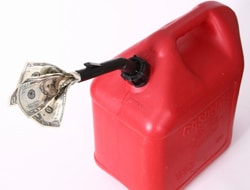
With fuel prices stuck on high, using better planning, driving and vehicle maintenance practices can help you get more miles to the gallons and better value as you top off your tank.
Frank Kelly, wheelchair user and certified mobility consultant for IMED Mobility, Roseville, Minn., says while newer vans are getting better mileage, he knows he could get better mileage in his 2005 Chrysler Town & Country minivan using better driving practices.
“I drive in the fast lane and get 19.8 mpg,” says Kelly. “If I would slow down and drive the speed limit, I’d probably get an additional 3-4 mpg. But I weigh it as, what’s my time worth if it takes me 15 minutes more to get somewhere?”
Prior to moving closer to work, Kelly drove 100 miles round trip. Now with a 12-mile round trip, he noticed his mpg has dropped to 12-14. He figures it’s the difference between driving non-stop on a highway and stopping, idling and starting at six four-way stop signs.
Here are more ways to get better mileage while gas prices stay high:
1. Maintain proper tire inflation (can result in fuel savings of 4 percent).
2. Tune your engine and change oil and air filters on a regular basis. A dirty air filter — something you or a friend can easily change (saving labor costs) — can decrease mpg by 1-2, translating to $.04-.07 cents per gallon.
3. Slow down: Observe speed limits. Driving aggressively, speeding and braking hard can lower your mpg 5-33 percent, according to www.fueleconomy.gov. Most of today’s vehicles get optimum fuel economy at 55 mph, and every 5 mph you drive over 50 is like paying an extra $.25 cents per gallon. Also, www.GasBuddy.com says slowing down when you see a red light ahead may allow you to coast through a green light, avoiding stopping and idling. Jackrabbit starts, quick stops and riding the brake can add one-third to your fuel costs.
4. Fill ’er up or not? No need to top off the tank every chance you get. Wait until it is down to a quarter of a tank before re-filling. Not only is a lighter tank better on gas mileage, it will eliminate several trips to the station. Gas up in the early morning or late night, especially in summer or on sunny days. Gas expands in the heat and reduces density, thereby reducing the amount of product per gallon.
5. Don’t Idle: When stuck in traffic or at an accident or road construction site, turn off your car if stopped more than 30 seconds. And, unless the weather warrants it, no need to warm up your car before driving — there is no benefit to the vehicle.
6. Use your vehicle’s features: Maintain constant speed on the highway by using cruise control; use overdrive to slow down your engine’s speed. Both save gas.
7. Remove extra weight. This is especially important when a van conversion can add 300 pounds or more and a power chair can add upwards of 300-plus pounds. Eliminate extra tie-downs, ramps or other miscellaneous items.
8. Clip Coupons: Find out if your local grocer or buying club offers money-saving coupons for your favorite gas station; if gas stations offer a rewards program or double-coupon days; or if your credit card has a gas rebate program.
9. Plan Ahead: No matter where you are headed, map a route that offers the least amount of stopping and starting, and plan several stops at a time to avoid several short trips with a cold engine. If running errands, do so on Tuesdays or Wednesdays — slow shopping days — during non-rush hour times. Or, shop online where you can get free delivery and often better pricing or daily deals from stores such as Target, Wal-Mart, popular pharmacies, local grocers and your favorite clothing stores. You can also use online services such as your local library, movie rental, banking and utilities bill paying.
10. Consider ride-sharing with a co-worker, use public transportation one or two days a week or ask your boss if you can telecommute one or two days a week. Stagger work hours to avoid rush hour traffic.
11. And, of course, find the cheapest gas. In metro areas, typically the cheapest gas can be found in the suburbs; stay away from affluent neighborhoods; and don’t hit the first station you see off the freeway. Check online for the many sites that list daily gas prices to see which station is cheapest and closest.
More than likely, gas prices will continue to go up instead of down. Arming yourself with these best practices can help you get the most out of your fuel consumption while maintaining your vehicle and pocket book.
Support New MobilityWait! Before you wander off to other parts of the internet, please consider supporting New Mobility. For more than three decades, New Mobility has published groundbreaking content for active wheelchair users. We share practical advice from wheelchair users across the country, review life-changing technology and demand equity in healthcare, travel and all facets of life. But none of this is cheap, easy or profitable. Your support helps us give wheelchair users the resources to build a fulfilling life. |


Recent Comments
Glen Gregos on Traveling With and Without a Caregiver
Sue on Controller Recall Puts SmartDrive Safety in the Spotlight
David Anderson on Phoenix i is the First Wheelchair with Integrated Power Assist